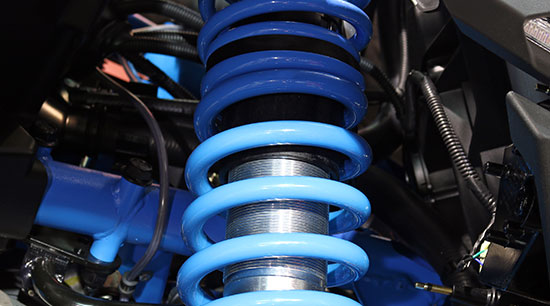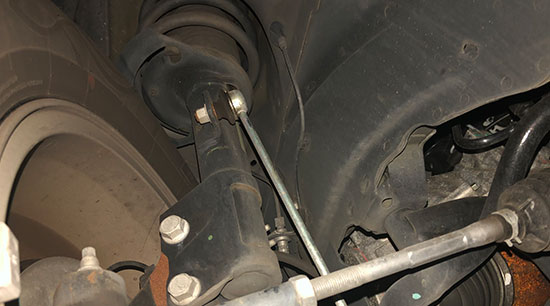Are worn-out shock absorbers robbing you of a smooth ride in your car? By knowing when to replace them, you can prevent the anxiety of a bumpy ride and several mechanical problems down the road.

autobahn-performance.com gathered information about when shock absorbers should be replaced, signs they have failed, the damage they can contribute to over time, and their purpose.
When Should You Replace Your Car’s Shock Absorbers?
Shock absorbers, unlike other vehicle parts, do not have a set expiration date or set mileage. Depending on the amount and under what conditions you drive, they can last far past the 50,000 mile standard. The following are indicators that your shock absorbers need to be replaced:
Bumpy Ride – When your shock absorbers are nearing the end of their useful life, the ride in the vehicle will become bumpy. In fact, as this worsens, you will feel nearly all defects or imperfections on the road. Especially hard drops off of speed bumps.
Braking Problems – Ineffective or bad shock absorbers allow the front-end of your vehicle to “dip” or “squat” when the brakes are applied. The added stress on your brakes can cause a longer stopping distance of 20% or greater.
NOTE: This becomes a significant hazard when driving conditions are combined with rain, snow, or ice.
Steering Problems – Shock absorbers help stabilize your vehicle by maintaining balance and center of gravity. When they fail, you may feel your car sway, dip, or lift as you make turns at different speeds and degrees.
Unusual Tread Wear – Over time, due to your car’s loss of balance, your tires may begin to show strange and uneven wear patterns.

Tip: On your next oil change, request that the mechanic rotate your tires, inspect the tread wear, and evaluate the suspension system.
Fluid Leaks – Another telling sign that you need new shock absorbers is when they leak oil. If you see oil on the lower portion of the absorbers, on the inner walls of your tires, or spots on the ground in their location when you park, this is a strong indication that you need to replace your shock absorbers.
NOTE: Brake fluid leaks may present the same signs as a shock absorber leak. If you are unable to determine the source of the leak, it is recommended NOT to operate the vehicle and call a mobile mechanic to verify the source.
Mileage – Decades ago, the “rule-of-thumb” was to have your shock absorbers replaced every 50,000 miles. However, as vehicle technology and the quality of parts have greatly improved, your factory shock absorbers can last anywhere from 50,000 to 100,000 miles.
When any of these indicators are present, it is strongly recommended to have your vehicle’s suspension system checked by a trusted auto repair shop as quickly as possible.
Tip: Not all vehicles use shock absorbers on all four wheels. It is common to see shocks on the rear tires and struts on the front.
What Is The Difference Between A Shock and A Strut?
A vehicle will have either a shock or a strut found at each wheel (never both). The two components are significantly different in that:
• A strut is a structural part of the vehicle’s suspension system
• Shocks are attached to the suspension system
• Struts are also a part of the vehicle’s steering system and can significantly influence alignment angles.
Besides these differences, there is also a significant disparity between the cost of shock absorbers and struts. Struts are far more costly in comparison to shocks.
Shocks on the rear suspension of a vehicle:

Both components serve to stabilize your vehicle, whether it is in motion or not. Shocks and struts contribute to a smooth and safe ride and should be replaced when they wear out.
Struts on the front suspension of a vehicle:

NOTE: Shocks cannot replace struts, and struts cannot replace shocks. They are entirely different components.
Shock Absorber Replacement
Before replacing your shock absorbers or struts, you should have your entire suspension inspected for part wear, damage, and leaks. Other components that can cause your suspension system to underperform may include:
• Ball Joints
• Tie Rods
• Control Arms
• Springs
Some manufacturers recommend replacement at 50,000 miles, but a more reasonable approach is to have the shocks, struts, and suspension system inspected at 50,000 miles, then annually after that.
A thorough inspection by a trusted auto repair shop should uncover what parts, if any, need replacement.
Tip: Never replace a single shock absorber or a single strut. To avoid erratic vehicle operation and handling, they should always be replaced in pairs.
When Do Shocks And Struts Need To Be Replaced?
In this article, you discovered information to help you determine when to replace your car’s shock absorbers, signs that they have worn out, damages they can cause, and their purpose.
By having your car’s suspension system inspected and replacing your shocks or struts when they fail, you add to the comfort and security of your commute.
Allowing your shocks and struts to wear out without taking action, you are contributing to the stress and damage to other vital systems and parts of your vehicle.
Sources:
carid.com/articles/when-is-it-time-to-replace-my-shock-absorbers.html
cars.com/articles/how-long-should-shock-absorbers-last-1420676937486/
consumer.ftc.gov/articles/0211-auto-repair-basics
shockwarehouse.com/news/differenceshocksstruts.cfm
Autobahn Performance
(770) 409-8288